warning light TOYOTA FJ CRUISER 2010 1.G Owners Manual
[x] Cancel search | Manufacturer: TOYOTA, Model Year: 2010, Model line: FJ CRUISER, Model: TOYOTA FJ CRUISER 2010 1.GPages: 439, PDF Size: 11.02 MB
Page 2 of 439

TABLE OF CONTENTSIndex
2
1-1. Key information
Keys ..................................... 28
1-2. Opening, closing and locking
the doors
Wireless remote control ....... 30
Side doors ............................ 33
Access doors........................ 36
Back door ............................. 38
Glass hatch .......................... 43
1-3. Adjustable components
(seats, mirrors, steering
wheel)
Front seats ........................... 47
Rear seats ............................ 49
Head restraints ..................... 54
Seat belts ............................. 57
Steering wheel ..................... 63
Anti-glare inside rear view
mirror .................................. 64
Outside rear view mirrors ..... 68
1-4. Opening and closing the
windows
Power windows .................... 71
1-5. Refueling
Opening the fuel tank cap .... 731-6. Theft deterrent system
Engine immobilizer
system ................................ 77
Theft prevention labels
(U.S.A.)............................... 79
1-7. Safety information
Correct driving posture ......... 80
SRS airbags ......................... 82
Front passenger occupant
classification system ........... 95
Child restraint systems ....... 100
Installing child restraints ..... 104
2-1. Driving procedures
Driving the vehicle .............. 116
Engine (ignition) switch....... 126
Automatic Transmission ..... 129
Manual Transmission ......... 131
Turn signal lever ................. 133
Parking brake ..................... 134
Horn .................................... 136
2-2. Instrument cluster
Gauges and meters ............ 137
Indicators and warning
lights ................................. 140
Accessory meter ................. 143
1Before driving
2When driving
Page 5 of 439

1
2
3
4
5
6
7
5
5-2. Steps to take in an emergency
If a warning light turns on
or a warning buzzer
sounds... ........................... 354
If you have a flat tire............ 364
If the engine will not start .... 376
If the shift lever cannot be
shifted from P.................... 377
If you lose your keys ........... 378
If the vehicle battery is
discharged ........................ 379
If your vehicle overheats ..... 382
If the vehicle becomes
stuck ................................. 385
6-1. Specifications
Maintenance data
(fuel, oil level, etc.) ............ 388
Fuel information .................. 398
Tire information ................... 401
6-2. Customization
Customizable features ........ 412
Items to initialize ................. 414Reporting safety defects
for U.S. owners ................ 416
Seat belt instructions for
Canadian owners
(in French) ........................ 417
Abbreviation list ........................ 420
Alphabetical index .................... 422
What to do if... ........................... 430
6Vehicle specifications
7For owners
Index
Page 61 of 439
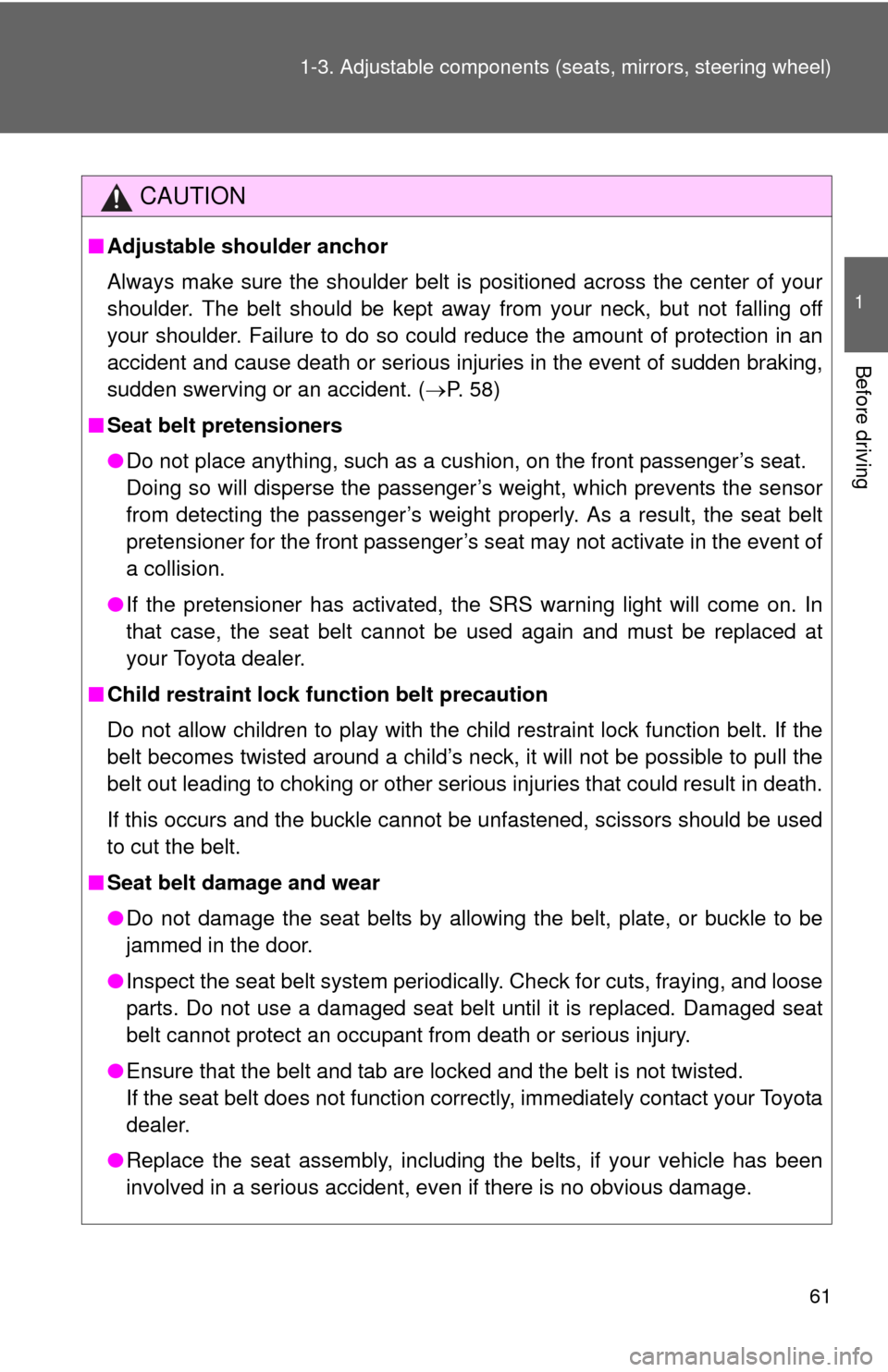
61 1-3. Adjustable components (seats, mirrors, steering wheel)
1
Before driving
CAUTION
■Adjustable shoulder anchor
Always make sure the shoulder belt is positioned across the center of your
shoulder. The belt should be kept away from your neck, but not falling off
your shoulder. Failure to do so could reduce the amount of protection in an
accident and cause death or serious injuries in the event of sudden braking,
sudden swerving or an accident. (P. 58)
■Seat belt pretensioners
●Do not place anything, such as a cushion, on the front passenger’s seat.
Doing so will disperse the passenger’s weight, which prevents the sensor
from detecting the passenger’s weight properly. As a result, the seat belt
pretensioner for the front passenger’s seat may not activate in the event of
a collision.
●If the pretensioner has activated, the SRS warning light will come on. In
that case, the seat belt cannot be used again and must be replaced at
your Toyota dealer.
■Child restraint lock function belt precaution
Do not allow children to play with the child restraint lock function belt. If the
belt becomes twisted around a child’s neck, it will not be possible to pull the
belt out leading to choking or other serious injuries that could result in death.
If this occurs and the buckle cannot be unfastened, scissors should be used
to cut the belt.
■Seat belt damage and wear
●Do not damage the seat belts by allowing the belt, plate, or buckle to be
jammed in the door.
●Inspect the seat belt system periodically. Check for cuts, fraying, and loose
parts. Do not use a damaged seat belt until it is replaced. Damaged seat
belt cannot protect an occupant from death or serious injury.
●Ensure that the belt and tab are locked and the belt is not twisted.
If the seat belt does not function correctly, immediately contact your Toyota
dealer.
●Replace the seat assembly, including the belts, if your vehicle has been
involved in a serious accident, even if there is no obvious damage.
Page 77 of 439
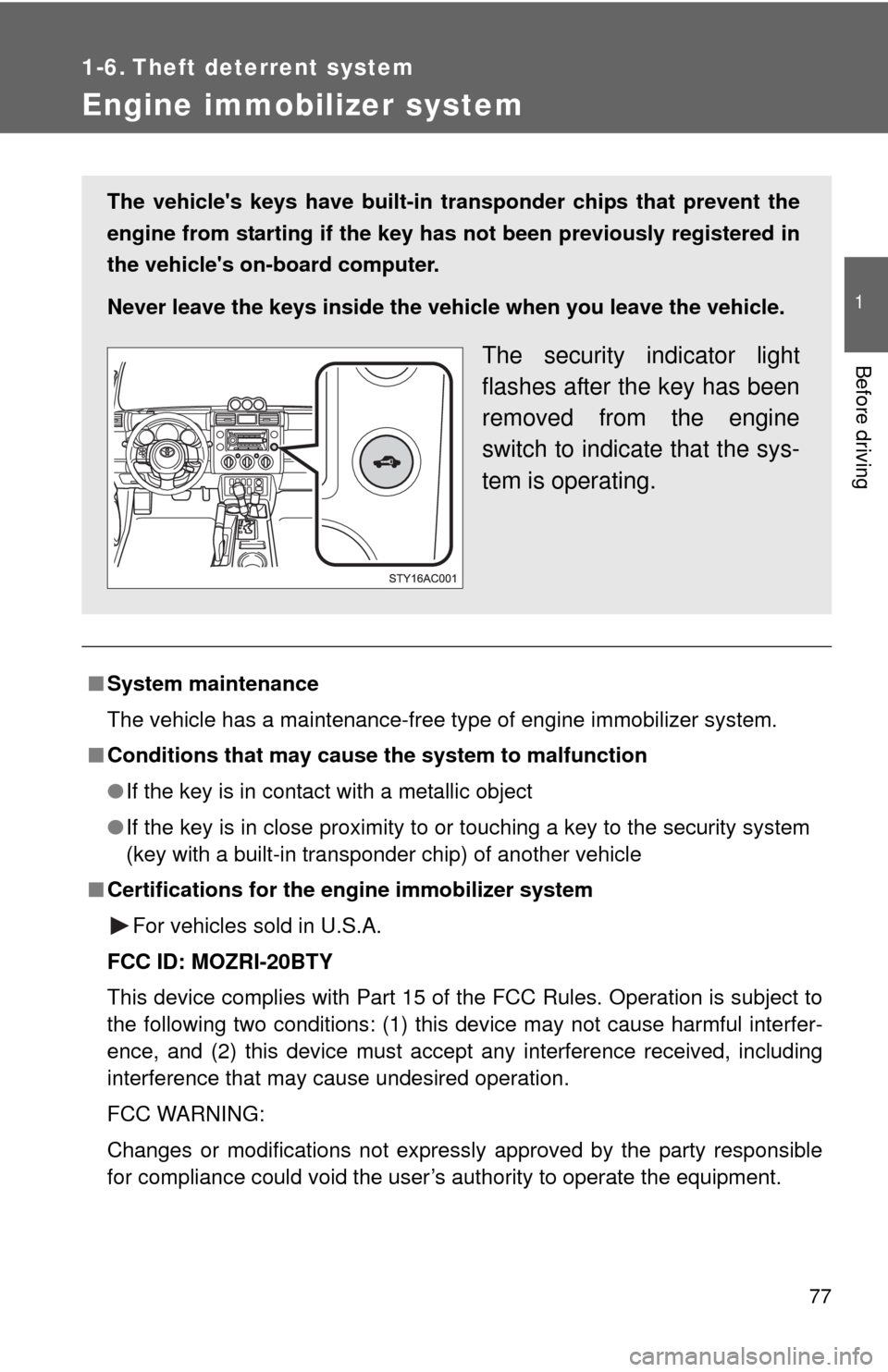
77
1
Before driving
1-6. Theft deterrent system
Engine immobilizer system
■System maintenance
The vehicle has a maintenance-free type of engine immobilizer system.
■Conditions that may cause the system to malfunction
●If the key is in contact with a metallic object
●If the key is in close proximity to or touching a key to the security system
(key with a built-in transponder chip) of another vehicle
■Certifications for the engine immobilizer system
For vehicles sold in U.S.A.
FCC ID: MOZRI-20BTY
This device complies with Part 15 of the FCC Rules. Operation is subject to
the following two conditions: (1) this device may not cause harmful interfer-
ence, and (2) this device must accept any interference received, including
interference that may cause undesired operation.
FCC WARNING:
Changes or modifications not expressly approved by the party responsible
for compliance could void the user’s authority to operate the equipment.
The vehicle's keys have built-in transponder chips that prevent the
engine from starting if the key has not been previously registered in
the vehicle's on-board computer.
Never leave the keys inside the vehicle when you leave the vehicle.
The security indicator light
flashes after the key has been
removed from the engine
switch to indicate that the sys-
tem is operating.
Page 83 of 439
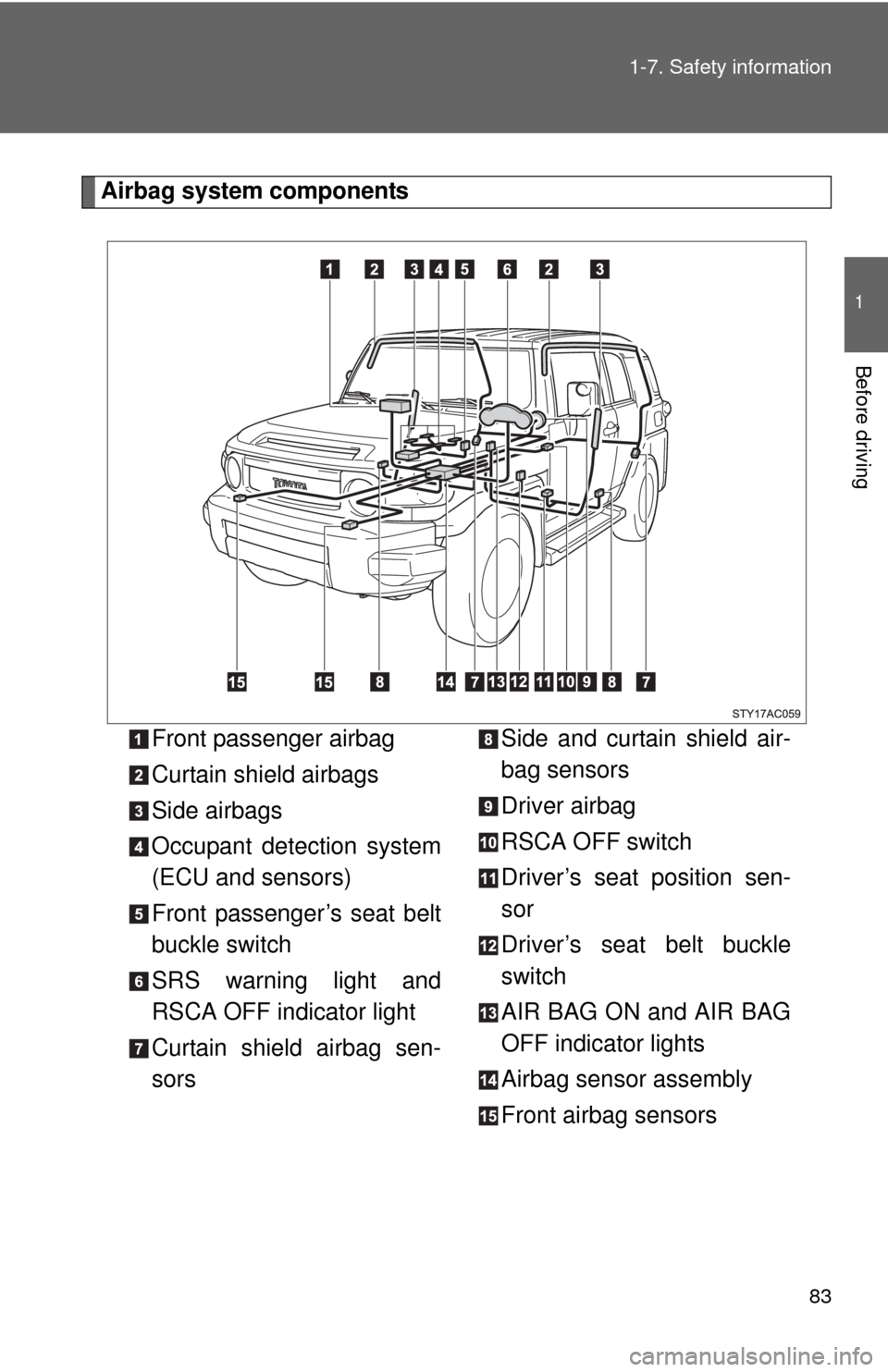
83 1-7. Safety information
1
Before driving
Airbag system components
Front passenger airbag
Curtain shield airbags
Side airbags
Occupant detection system
(ECU and sensors)
Front passenger’s seat belt
buckle switch
SRS warning light and
RSCA OFF indicator light
Curtain shield airbag sen-
sorsSide and curtain shield air-
bag sensors
Driver airbag
RSCA OFF switch
Driver’s seat position sen-
sor
Driver’s seat belt buckle
switch
AIR BAG ON and AIR BAG
OFF indicator lights
Airbag sensor assembly
Front airbag sensors
Page 84 of 439

84 1-7. Safety information
Your vehicle is equipped with ADVANCED AIRBAGS designed based
on US motor vehicle safety standards (FMVSS208). The airbag sys-
tem controls airbag deployment power for the driver and front pas-
senger. The driver airbag system consists of the driver seat’s position
sensor etc. The front passenger’s airbag system consists of the front
passenger occupant classification sensor etc.
The main SRS airbag system components are shown above. The
SRS airbag system is controlled by the airbag sensor assembly. The
airbag sensor assembly consists of a safing sensor and an airbag
sensor.
In certain types of severe frontal or side impacts, the SRS airbag sys-
tem triggers the airbag inflators. A chemical reaction in the inflators
quickly fills the airbags with non-toxic gas to help restrain the motion
of the occupants.
■SRS warning light
This warning light system monitors the airbag sensor assembly, front airbag
sensors, side and curtain shield airbag sensor assemblies, curtain shield air-
bag sensor assemblies, driver’s seat position sensor, driver’s seat belt
buckle switch, front passenger occupant classification system, AIR BAG ON
indicator light, AIR BAG OFF indicator light, front passenger’s seat belt
buckle switch, seat belt pretensioner assemblies, RSCA OFF indicator light,
inflators, interconnecting wiring and power sources. (P. 355)
■If the SRS airbags deploy (inflate)
●Bruising and slight abrasions may result from contact with a deploying
(inflating) SRS airbag.
●A loud noise and white powder will be emitted.
●Parts of the airbag module (steering wheel hub, airbag cover and inflator)
as well as the front seats, and parts of the front and rear pillars and roof
side rail, may be hot for several minutes. The airbag itself may also be
hot.
●The front windshield may crack.
Page 95 of 439
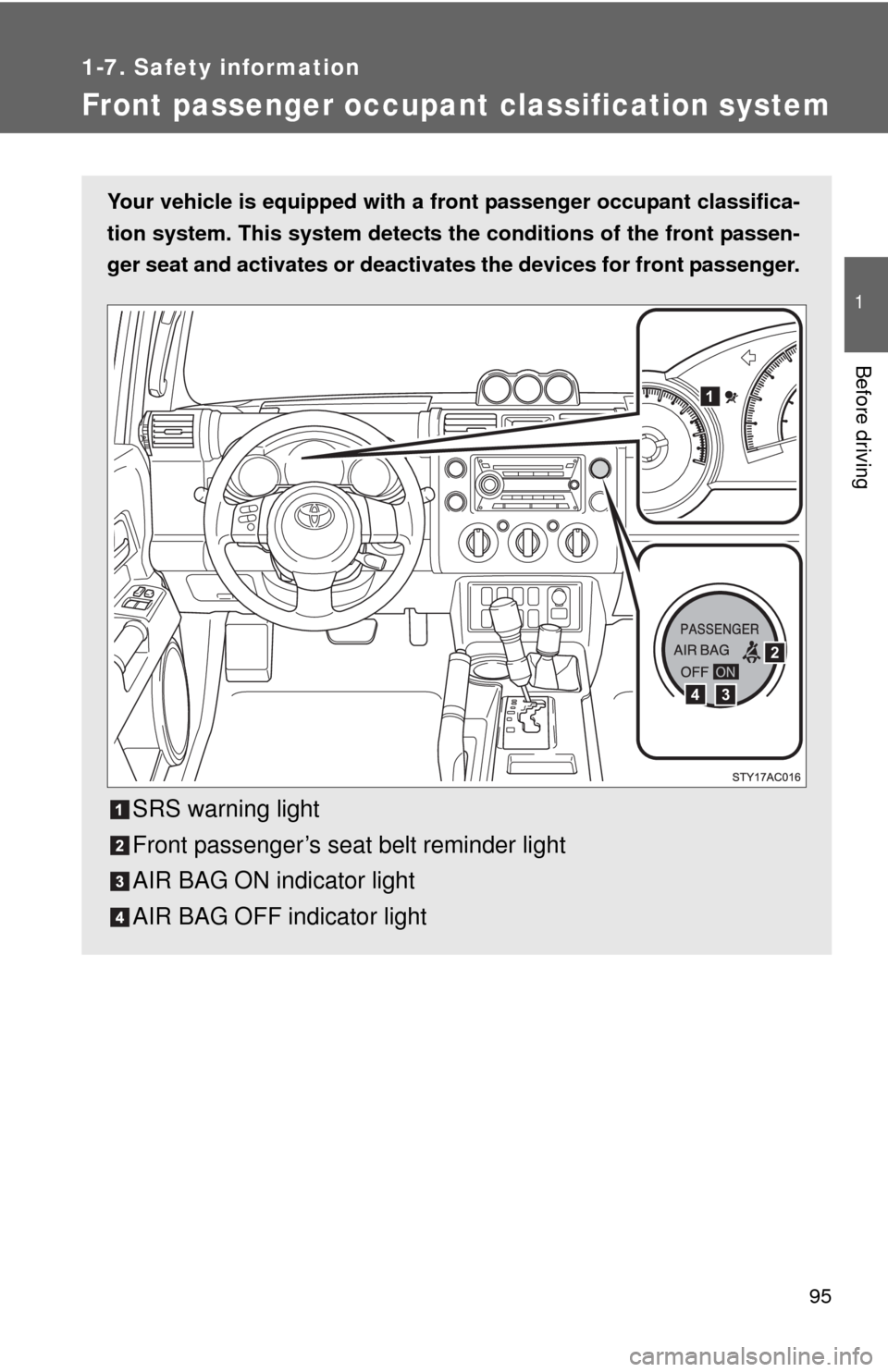
95
1
1-7. Safety information
Before driving
Front passenger occupant classification system
Your vehicle is equipped with a front passenger occupant classifica-
tion system. This system detects the conditions of the front passen-
ger seat and activates or deactivates the devices for front passenger.
SRS warning light
Front passenger’s seat belt reminder light
AIR BAG ON indicator light
AIR BAG OFF indicator light
2
1
34
Page 96 of 439

96 1-7. Safety information
Condition and operation in the front passenger occupant classification system
■Adult *1
■Child*3 or child restraint system*4
■Unoccupied
Indicator/
warning lightAIR BAG ON and AIR BAG OFF indicator
lightsAIR BAG ON
SRS warning light Off
Front passenger’s seat belt reminder light
Flashing
*2
DevicesFront passenger airbag
Activated Side airbag on the front passenger seat
Curtain shield airbag in the front passenger
side
Front passenger’s seat belt pretensioner
Indicator/
warning lightAIR BAG ON and AIR BAG OFF indicator
lightsAIR BAG
OFF
*5
SRS warning light
Off
Front passenger’s seat belt reminder light
Flashing
*2
DevicesFront passenger airbag
Deactivated
Side airbag on the front passenger seat
Curtain shield airbag in the front passenger
side
Activated
Front passenger’s seat belt pretensioner
Indicator/
warning lightAIR BAG ON and AIR BAG OFF indicator
lights
Not illuminated
SRS warning light
Off
Front passenger’s seat belt reminder light
DevicesFront passenger airbag
Deactivated
Side airbag on the front passenger seat
Curtain shield airbag in the front passenger
sideActivated
Front passenger’s seat belt pretensioner Deactivated
Page 97 of 439

97 1-7. Safety information
1
Before driving
■There is a malfunction in the system
*1:The system judges a person of adult size as an adult. When a
smaller adult sits in the front passenger seat, the system may rec-
ognize him/her as a child depending on his/her physique and pos-
ture.
*2:In the event the front passenger does not wear a seat belt.
*3:When a larger child who has outgrown a child restraint system sits
in the front passenger seat, the system may recognize him/her as
an adult depending on his/her physique or posture.
*4:Never install a rear-facing child restraint system on the front pas-
senger seat. A forward-facing child restraint system should only be
installed on the front passenger seat when it is unavoidable. (P.
100)
*5:In case the indicator is not illuminated, consult this manual as for
installing the child restraint system properly. (P. 104)
Indicator/
warning lightAIR BAG ON and AIR BAG OFF indicator
lightsAIR BAG
OFF
SRS warning light On
Front passenger’s seat belt reminder light Off
DevicesFront passenger airbag
Deactivated
Side airbag on the front passenger seat
Curtain shield airbag in the front passenger
side
Activated
Front passenger’s seat belt pretensioner
Page 99 of 439
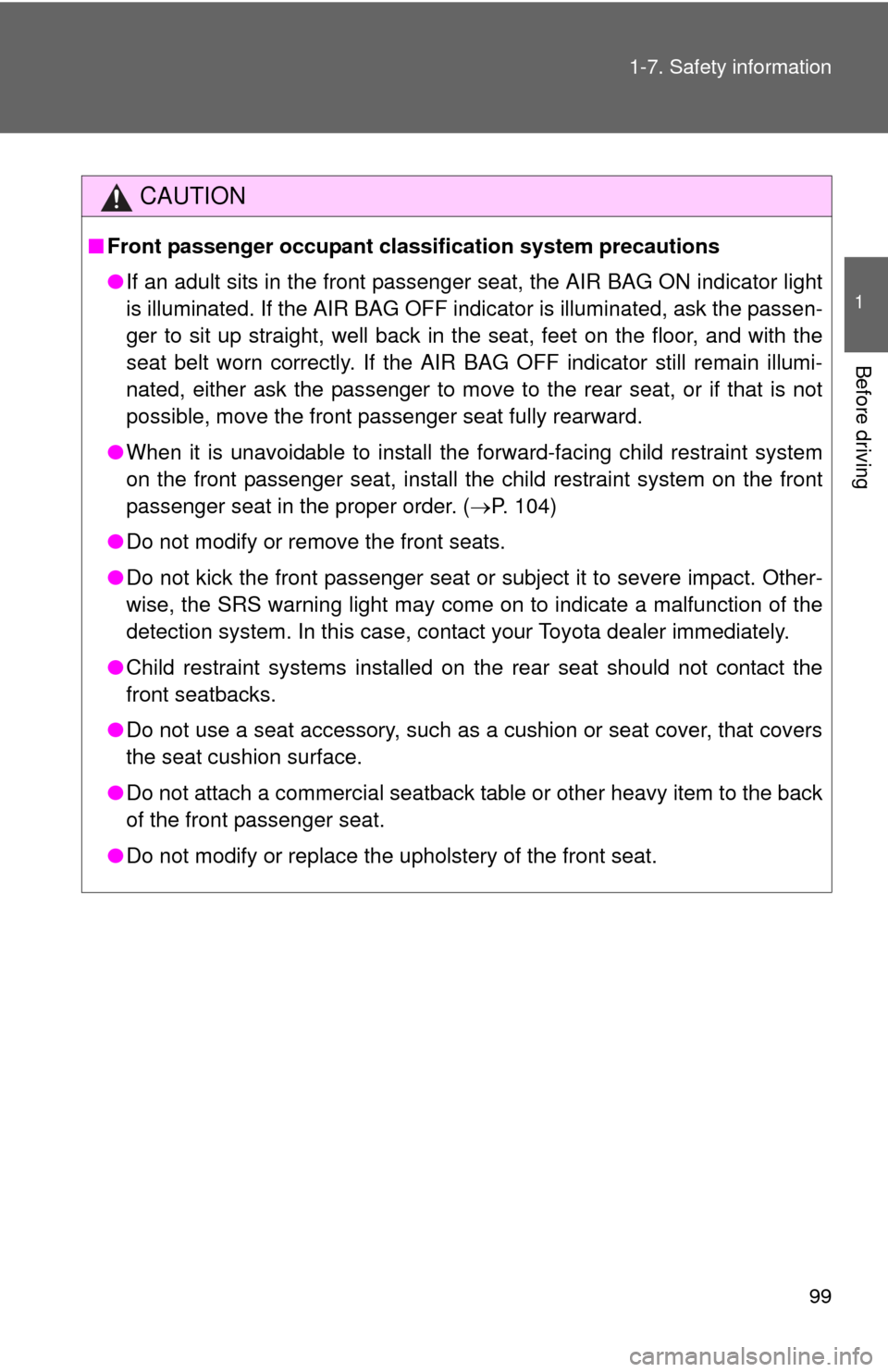
99 1-7. Safety information
1
Before driving
CAUTION
■Front passenger occupant classification system precautions
●If an adult sits in the front passenger seat, the AIR BAG ON indicator light
is illuminated. If the AIR BAG OFF indicator is illuminated, ask the passen-
ger to sit up straight, well back in the seat, feet on the floor, and with the
seat belt worn correctly. If the AIR BAG OFF indicator still remain illumi-
nated, either ask the passenger to move to the rear seat, or if that is not
possible, move the front passenger seat fully rearward.
●When it is unavoidable to install the forward-facing child restraint system
on the front passenger seat, install the child restraint system on the front
passenger seat in the proper order. (P. 104)
●Do not modify or remove the front seats.
●Do not kick the front passenger seat or subject it to severe impact. Other-
wise, the SRS warning light may come on to indicate a malfunction of the
detection system. In this case, contact your Toyota dealer immediately.
●Child restraint systems installed on the rear seat should not contact the
front seatbacks.
●Do not use a seat accessory, such as a cushion or seat cover, that covers
the seat cushion surface.
●Do not attach a commercial seatback table or other heavy item to the back
of the front passenger seat.
●Do not modify or replace the upholstery of the front seat.